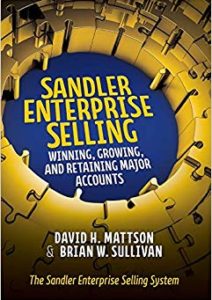Selling teams often struggle with analyzing enterprise wins and losses. Human nature in sales, of course, typically motivates rapid movement to the next deal and hopefully, the next win. But hope, as we all know, is not a strategy.
But the most important reason that effective win-loss analysis rarely happens, if at all, isn’t about the selling psyche. It’s about the lack of practical Go/No-Go processes that dictate whether major deals should be pursued in the first place. And if they are, it’s how to mitigate the risks and maximize the likelihood of winning.
Think about it. If you’re desperately lost for hours in freezing dark woods on a snowy night and you feel your way, blindly grabbing at trees until you stumble onto the shoulder of a road, you are indeed very fortunate to survive. And when the driver of the car that picks you up asks how you made it through that dense forest in the dark, you confess to having no clue – no strategy to share, no lessons learned. And had your trek not ended so fortuitously, lacking a strategy could have led to a more chilling end to the story.
And what about enterprise deals that selling teams pursue? What are the typical reasons for moving ahead? “It’s a big deal”, “we can win this” or “they really want us to bid”. But these critical decisions simply can’t be dictated by emotion or hearsay. The stakes are too high. Logic and practical decision-making must prevail.
In Sandler Enterprise Selling, we follow a framework to review a deal’s key issues before deciding on proceeding or passing. We call it Pursuit Navigator and navigation is exactly what it provides. Issues are evaluated in three categories – client issues, selling team issues and financing/contract issues. In a team forum, accountable members of the selling organization assemble to provide input. For each issue, you must determine whether you’re stable or whether there’s risk. If risk is identified, it must be quickly determined what mitigation actions, if any, can be taken. Examples of issues could be, ”we don’t have multi-level contacts”, “the account’s financial stability is uncertain” or “we’ve never delivered the solution before” and many more. Important items to know about? Absolutely, but also to strategize for by executing real actions to mitigate the risk. And as quickly as possible.
It’s hard to imagine not utilizing this type of analysis given the investment required in enterprise pursuits. A client recently told me, “Every opportunity we decide to go after costs us $40,000 – win or lose, $40,000”. And that’s just the financial investment. What about your people who are engaged in enterprise pursuits? There’s an opportunity cost when their everyday work is stopped or stalled. And how about your organization’s overall energy? How many significant deals can you credibly pursue at the same time? And if you decide to cut corners to pursue multiple deals, capable competitors will be laser-focused on each one, creating formidable challenges.
But using a logical Go/No-Go process like Pursuit Navigator to effectively mitigate risks makes your decision to proceed or pass an educated one. If you choose to move ahead and submit a proposal, your chances of success are greatly increased. Then, likely in a few weeks, one of two things will happen. You’ll win and move swiftly to get the contract signed and kick off the business relationship. Or you’ll lose. And even through your very best efforts, in the enterprise world, losing happens. You’ll be eager, of course, to debrief with the account but be professional and respect the moment. They’re very busy with your winning competitor, ramping things up.
Then there’s that win-loss analysis, the format of which is often a mystery to selling organizations. But what’s different now? What’s different is that your decision to move ahead was based on a logical Go/No-Go process. Your analysis, your post-mortem, now has a framework – the very Go/No-Go process that dictated your decision to proceed. And your loss provides real insights because you missed something. Maybe you underestimated the severity of a risk. Or perhaps you judged that you were stable in an issue where you were not. Reviewing those same issues now, in the clarity of the post-mortem, sets the stage to turn your loss into an advance. For identifying your previous mistakes insures that your next opportunity’s Go/No-Go process will be more effective, increasing your probability of winning through valuable lessons learned. You win or you learn.
So, make your win-loss analysis truly impactful by conducting an effective Go/No-Go process. While post-mortems provide certainty regarding the causes of death, your stories will have happier endings if the danger signals are diagnosed and treated while you still have the chance to do something about them!
Pipeliner CRM empowers powerful win-loss analysis. Get your free trial of Pipeliner CRM now.















































Comments